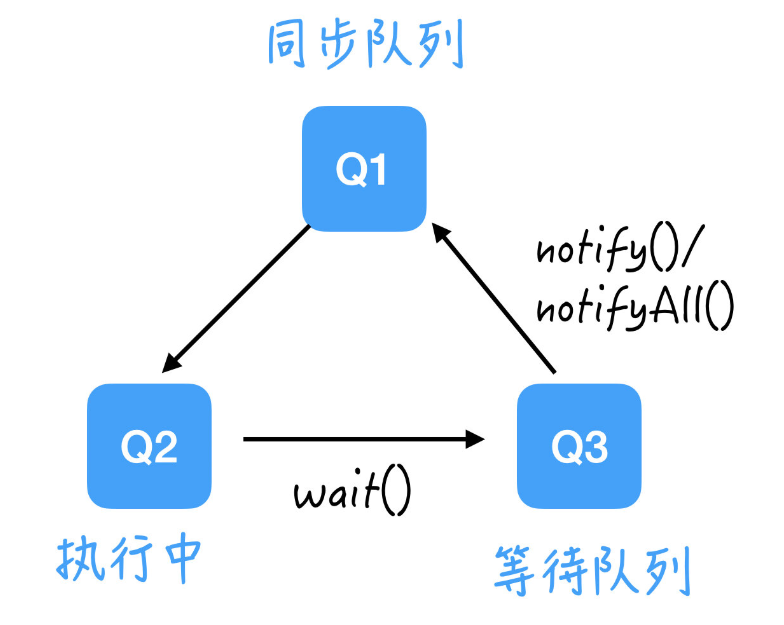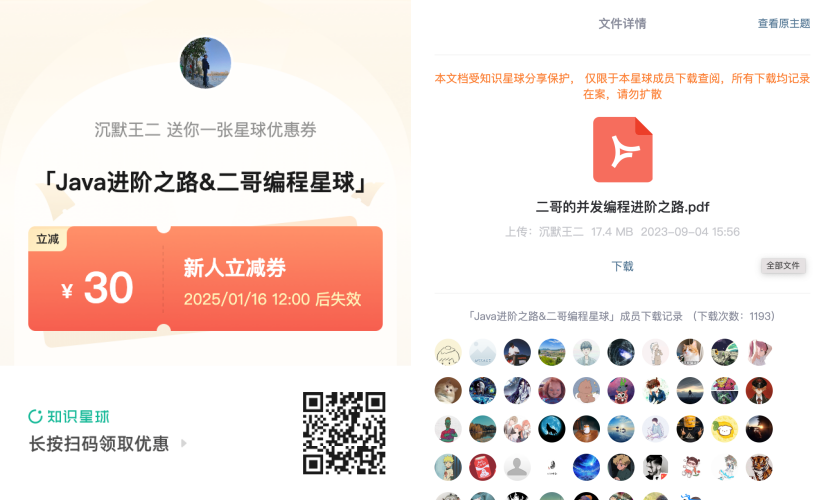从根上理解生产者-消费者模式
生产者-消费者模式是一个十分经典的多线程并发协作模式,弄懂生产者-消费者问题能够让我们对并发编程的理解加深。
所谓的生产者-消费者,实际上包含了两类线程,一种是生产者线程用于生产数据,另一种是消费者线程用于消费数据,为了解耦生产者和消费者的关系,通常会采用共享的数据区域,就像是一个仓库,生产者生产数据之后直接放置在共享数据区中,并不需要关心消费者的行为;而消费者只需要从共享数据区中获取数据,不需要关心生产者的行为。

这个共享数据区域中应该具备这样的线程间并发协作功能:
- 如果共享数据区已满的话,阻塞生产者继续生产数据;
- 如果共享数据区为空的话,阻塞消费者继续消费数据;
在实现生产者消费者问题时,可以采用三种方式:
- 使用 Object 的 wait/notify 的消息通知机制;
- 使用 Lock Condition 的 await/signal 消息通知机制;
- 使用 BlockingQueue 实现。
wait/notify 的消息通知机制
可以通过 Object 对象的 wait 方法和 notify 方法或 notifyAll 方法来实现线程间的通信。

调用 wait 方法将阻塞当前线程,直到其他线程调用了 notify 方法或 notifyAll 方法进行通知,当前线程才能从 wait 方法处返回,继续执行下面的操作。
这些知识我们在讲 Condition 的时候其实讲到过,相信大家都还有印象。
01、wait
该方法用来将当前线程置入休眠状态,直到接到通知或被中断为止。
在调用 wait 之前,线程必须获得该对象的监视器锁,即只能在同步方法或同步块中调用 wait 方法。调用 wait 方法之后,当前线程会释放锁。如果调用 wait 方法时,线程并未获取到锁的话,则会抛出 IllegalMonitorStateException异常。如果再次获取到锁的话,当前线程才能从 wait 方法处成功返回。
02、notify
该方法也需要在同步方法或同步块中调用,即在调用前,线程也必须获得该对象的对象级别锁,如果调用 notify 时没有持有适当的锁,也会抛出 IllegalMonitorStateException。
该方法会从 WAITTING 状态的线程中挑选一个进行通知,使得调用 wait 方法的线程从等待队列移入到同步队列中,等待机会再一次获取到锁,从而使得调用 wait 方法的线程能够从 wait 方法处退出。
调用 notify 后,当前线程不会马上释放该对象锁,要等到程序退出同步块后,当前线程才会释放锁。
03、notifyAll
该方法与 notify 方法的工作方式相同,重要的一点差异是:notifyAll 会使所有原来在该对象上 wait 线程统统退出 WAITTING 状态,使得他们全部从等待队列中移入到同步队列中去,等待下一次获取到对象监视器锁的机会。
不过,wait/notify 消息通知存在这样一些问题。
1.notify 早期通知
notify 通知的遗漏,即 threadA 还没开始 wait,threadB 已经 notify 了,这样,threadB 通知是没有任何响应的,当 threadB 退出 synchronized 代码块后,threadA 再开始 wait,便会一直阻塞等待,直到被别的线程打断。
下面的示例代码就模拟出了 notify 早期通知带来的问题:
public class EarlyNotify {
private static String lockObject = "";
public static void main(String[] args) {
WaitThread waitThread = new WaitThread(lockObject);
NotifyThread notifyThread = new NotifyThread(lockObject);
notifyThread.start();
try {
Thread.sleep(3000);
} catch (InterruptedException e) {
e.printStackTrace();
}
waitThread.start();
}
static class WaitThread extends Thread {
private String lock;
public WaitThread(String lock) {
this.lock = lock;
}
@Override
public void run() {
synchronized (lock) {
try {
System.out.println(Thread.currentThread().getName() + " 进去代码块");
System.out.println(Thread.currentThread().getName() + " 开始wait");
lock.wait();
System.out.println(Thread.currentThread().getName() + " 结束wait");
} catch (InterruptedException e) {
e.printStackTrace();
}
}
}
}
static class NotifyThread extends Thread {
private String lock;
public NotifyThread(String lock) {
this.lock = lock;
}
@Override
public void run() {
synchronized (lock) {
System.out.println(Thread.currentThread().getName() + " 进去代码块");
System.out.println(Thread.currentThread().getName() + " 开始notify");
lock.notify();
System.out.println(Thread.currentThread().getName() + " 结束开始notify");
}
}
}
}示例中开启了两个线程,一个是 WaitThread,另一个是 NotifyThread。NotifyThread 会先启动调用 notify 方法。然后 WaitThread 线程才启动,调用 wait 方法,但由于通知过了,wait 方法就无法再获取到相应的通知,因此 WaitThread 会一直在 wait 方法处阻塞,这种现象就是通知过早的现象。
针对这种问题的解决方法是,添加一个状态标志,让 waitThread 调用 wait 方法前先判断状态是否已经改变了,如果通知已经发出,WaitThread 就不再去 wait。对上面的代码进行优化如下:
public class EarlyNotify {
private static String lockObject = "";
private static boolean isWait = true;
public static void main(String[] args) {
WaitThread waitThread = new WaitThread(lockObject);
NotifyThread notifyThread = new NotifyThread(lockObject);
notifyThread.start();
try {
Thread.sleep(3000);
} catch (InterruptedException e) {
e.printStackTrace();
}
waitThread.start();
}
static class WaitThread extends Thread {
private String lock;
public WaitThread(String lock) {
this.lock = lock;
}
@Override
public void run() {
synchronized (lock) {
try {
while (isWait) {
System.out.println(Thread.currentThread().getName() + " 进去代码块");
System.out.println(Thread.currentThread().getName() + " 开始wait");
lock.wait();
System.out.println(Thread.currentThread().getName() + " 结束wait");
}
} catch (InterruptedException e) {
e.printStackTrace();
}
}
}
}
static class NotifyThread extends Thread {
private String lock;
public NotifyThread(String lock) {
this.lock = lock;
}
@Override
public void run() {
synchronized (lock) {
System.out.println(Thread.currentThread().getName() + " 进去代码块");
System.out.println(Thread.currentThread().getName() + " 开始notify");
lock.notifyAll();
isWait = false;
System.out.println(Thread.currentThread().getName() + " 结束开始notify");
}
}
}
}这段代码只增加了一个isWait状态,NotifyThread 调用 notify 方法后会对状态进行更新,WaitThread 调用 wait 方法之前会先对状态进行判断。
该示例中,调用 notify 后将状态isWait改变为 false,因此,在 WaitThread 中 while 对 isWait 判断后就不会执行 wait 方法,从而避免了 Notify 过早通知造成遗漏的情况。
总结:在使用线程的等待/通知机制时,一般都要配合一个 boolean 变量值,在 notify 之前改变该 boolean 变量的值,让 wait 返回后能够退出 while 循环,或在通知被遗漏后不会被阻塞在 wait 方法处。
2.等待 wait 的条件发生变化
如果线程在等待时接收到了通知,但是之后等待的条件发生了变化,并没有再次对等待条件进行判断,也会导致程序出现错误。
下面用一个例子来说明这种情况。
public class ConditionChange {
private static List<String> lockObject = new ArrayList();
public static void main(String[] args) {
Consumer consumer1 = new Consumer(lockObject);
Consumer consumer2 = new Consumer(lockObject);
Productor productor = new Productor(lockObject);
consumer1.start();
consumer2.start();
productor.start();
}
static class Consumer extends Thread {
private List<String> lock;
public Consumer(List lock) {
this.lock = lock;
}
@Override
public void run() {
synchronized (lock) {
try {
//这里使用if的话,就会存在wait条件变化造成程序错误的问题
if (lock.isEmpty()) {
System.out.println(Thread.currentThread().getName() + " list为空");
System.out.println(Thread.currentThread().getName() + " 调用wait方法");
lock.wait();
System.out.println(Thread.currentThread().getName() + " wait方法结束");
}
String element = lock.remove(0);
System.out.println(Thread.currentThread().getName() + " 取出第一个元素为:" + element);
} catch (InterruptedException e) {
e.printStackTrace();
}
}
}
}
static class Productor extends Thread {
private List<String> lock;
public Productor(List lock) {
this.lock = lock;
}
@Override
public void run() {
synchronized (lock) {
System.out.println(Thread.currentThread().getName() + " 开始添加元素");
lock.add(Thread.currentThread().getName());
lock.notifyAll();
}
}
}
}会报异常:
Exception in thread "Thread-1" Thread-0 list为空
Thread-0 调用wait方法
Thread-1 list为空
Thread-1 调用wait方法
Thread-2 开始添加元素
Thread-1 wait方法结束
java.lang.IndexOutOfBoundsException: Index: 0, Size: 0在这个例子中,一共开启了 3 个线程,Consumer1,Consumer2 以及 Productor。
Consumer1 调用了 wait 方法后,线程处于了 WAITTING 状态,并且将对象锁释放。
此时,Consumer2 获取到对象锁,进入到同步代块中,当执行到 wait 方法时,同样的也会释放对象锁。
然后 productor 获取到对象锁,进入到同步代码块中,向 list 中插入数据,通过 notifyAll 方法通知处于 WAITING 状态的 Consumer1 和 Consumer2 线程。
consumer1 得到对象锁后,从 wait 方法处退出,删除一个元素让 List 为空,方法执行结束,退出同步块,释放掉对象锁。
这个时候 Consumer2 获取到对象锁后,从 wait 方法退出,继续往下执行,这个时候 Consumer2 再执行lock.remove(0);就会出错,因为 List 已经为空了。
解决方案: 通过上面的分析,可以看出 Consumer2 报错是因为线程从 wait 方法退出之后没有对 wait 条件进行判断,但此时的 wait 条件已经发生了变化。解决办法就是在 wait 退出之后再对条件进行判断。
public class ConditionChange {
private static List<String> lockObject = new ArrayList();
public static void main(String[] args) {
Consumer consumer1 = new Consumer(lockObject);
Consumer consumer2 = new Consumer(lockObject);
Productor productor = new Productor(lockObject);
consumer1.start();
consumer2.start();
productor.start();
}
static class Consumer extends Thread {
private List<String> lock;
public Consumer(List lock) {
this.lock = lock;
}
@Override
public void run() {
synchronized (lock) {
try {
//这里使用if的话,就会存在wait条件变化造成程序错误的问题
while (lock.isEmpty()) {
System.out.println(Thread.currentThread().getName() + " list为空");
System.out.println(Thread.currentThread().getName() + " 调用wait方法");
lock.wait();
System.out.println(Thread.currentThread().getName() + " wait方法结束");
}
String element = lock.remove(0);
System.out.println(Thread.currentThread().getName() + " 取出第一个元素为:" + element);
} catch (InterruptedException e) {
e.printStackTrace();
}
}
}
}
static class Productor extends Thread {
private List<String> lock;
public Productor(List lock) {
this.lock = lock;
}
@Override
public void run() {
synchronized (lock) {
System.out.println(Thread.currentThread().getName() + " 开始添加元素");
lock.add(Thread.currentThread().getName());
lock.notifyAll();
}
}
}
}上面的代码与之前的代码相比,仅仅只是将 wait 外围的 if 语句改为了 while 循环,这样当 list 为空时,线程便会继续等待,而不会继续去执行删除 list 中元素中的代码。
总结:在使用线程的等待/通知机制时,一般都要在 while 循环中调用 wait 方法,因此需要配合一个 boolean 变量,满足 while 循环的条件时进入 while 循环,执行 wait 方法,不满足 while 循环条件时,跳出循环,执行后面的代码。
3. “假死”状态
现象:如果是多消费者和多生产者情况,使用 notify 方法可能会出现“假死”的情况,即所有的线程都处于等待状态,无法被唤醒。
原因分析:假设当前有多个生产者线程调用了 wait 方法阻塞等待,其中一个生产者线程获取到对象锁之后使用 notify 通知处于 WAITTING 状态的线程,如果唤醒的仍然是生产者线程,就会造成所有的生产者线程都处于等待状态。
解决办法:将 notify 方法替换成 notifyAll 方法,如果使用的是 lock 的话,就将 signal 方法替换成 signalAll 方法。
总结:Object 提供的消息通知机制应该遵循如下这些条件:
- 永远在 while 循环中对条件进行判断而不是在 if 语句中进行 wait 条件的判断;
- 使用 NotifyAll 而不是使用 notify。
基本的使用范式如下:
// The standard idiom for calling the wait method in Java
synchronized (sharedObject) {
while (condition) {
sharedObject.wait();
// (Releases lock, and reacquires on wakeup)
}
// do action based upon condition e.g. take or put into queue
}wait/notifyAll 实现生产者-消费者
利用 wait/notifyAll 实现生产者和消费者代码如下:
public class ProductorConsumer {
public static void main(String[] args) {
LinkedList linkedList = new LinkedList();
ExecutorService service = Executors.newFixedThreadPool(15);
for (int i = 0; i < 5; i++) {
service.submit(new Productor(linkedList, 8));
}
for (int i = 0; i < 10; i++) {
service.submit(new Consumer(linkedList));
}
}
static class Productor implements Runnable {
private List<Integer> list;
private int maxLength;
public Productor(List list, int maxLength) {
this.list = list;
this.maxLength = maxLength;
}
@Override
public void run() {
while (true) {
synchronized (list) {
try {
while (list.size() == maxLength) {
System.out.println("生产者" + Thread.currentThread().getName() + " list以达到最大容量,进行wait");
list.wait();
System.out.println("生产者" + Thread.currentThread().getName() + " 退出wait");
}
Random random = new Random();
int i = random.nextInt();
System.out.println("生产者" + Thread.currentThread().getName() + " 生产数据" + i);
list.add(i);
list.notifyAll();
} catch (InterruptedException e) {
e.printStackTrace();
}
}
}
}
}
static class Consumer implements Runnable {
private List<Integer> list;
public Consumer(List list) {
this.list = list;
}
@Override
public void run() {
while (true) {
synchronized (list) {
try {
while (list.isEmpty()) {
System.out.println("消费者" + Thread.currentThread().getName() + " list为空,进行wait");
list.wait();
System.out.println("消费者" + Thread.currentThread().getName() + " 退出wait");
}
Integer element = list.remove(0);
System.out.println("消费者" + Thread.currentThread().getName() + " 消费数据:" + element);
list.notifyAll();
} catch (InterruptedException e) {
e.printStackTrace();
}
}
}
}
}
}输出结果:
生产者pool-1-thread-1 生产数据-232820990
生产者pool-1-thread-1 生产数据1432164130
生产者pool-1-thread-1 生产数据1057090222
生产者pool-1-thread-1 生产数据1201395916
生产者pool-1-thread-1 生产数据482766516
生产者pool-1-thread-1 list以达到最大容量,进行wait
消费者pool-1-thread-15 退出wait
消费者pool-1-thread-15 消费数据:1237535349
消费者pool-1-thread-15 消费数据:-1617438932
消费者pool-1-thread-15 消费数据:-535396055
消费者pool-1-thread-15 消费数据:-232820990
消费者pool-1-thread-15 消费数据:1432164130
消费者pool-1-thread-15 消费数据:1057090222
消费者pool-1-thread-15 消费数据:1201395916
消费者pool-1-thread-15 消费数据:482766516
消费者pool-1-thread-15 list为空,进行wait
生产者pool-1-thread-5 退出wait
生产者pool-1-thread-5 生产数据1442969724
生产者pool-1-thread-5 生产数据1177554422
生产者pool-1-thread-5 生产数据-133137235
生产者pool-1-thread-5 生产数据324882560
生产者pool-1-thread-5 生产数据2065211573
生产者pool-1-thread-5 生产数据253569900
生产者pool-1-thread-5 生产数据571277922
生产者pool-1-thread-5 生产数据1622323863
生产者pool-1-thread-5 list以达到最大容量,进行wait
消费者pool-1-thread-10 退出waitawait/signalAll 实现生产者-消费者
参照 Object 的 wait 和 notify/notifyAll 方法,Condition 也提供了同样的方法,即 await 方法和 signal/signalAll 方法。这部分知识我们前面在讲 Condition 的时候也讲到过,相信大家都还有印象。
那如果采用 Conditon 的消息通知原理来实现生产者-消费者模型,原理同使用 wait/notifyAll 一样。直接上代码:
public class ProductorConsumer {
private static ReentrantLock lock = new ReentrantLock();
private static Condition full = lock.newCondition();
private static Condition empty = lock.newCondition();
public static void main(String[] args) {
LinkedList linkedList = new LinkedList();
ExecutorService service = Executors.newFixedThreadPool(15);
for (int i = 0; i < 5; i++) {
service.submit(new Productor(linkedList, 8, lock));
}
for (int i = 0; i < 10; i++) {
service.submit(new Consumer(linkedList, lock));
}
}
static class Productor implements Runnable {
private List<Integer> list;
private int maxLength;
private Lock lock;
public Productor(List list, int maxLength, Lock lock) {
this.list = list;
this.maxLength = maxLength;
this.lock = lock;
}
@Override
public void run() {
while (true) {
lock.lock();
try {
while (list.size() == maxLength) {
System.out.println("生产者" + Thread.currentThread().getName() + " list以达到最大容量,进行wait");
full.await();
System.out.println("生产者" + Thread.currentThread().getName() + " 退出wait");
}
Random random = new Random();
int i = random.nextInt();
System.out.println("生产者" + Thread.currentThread().getName() + " 生产数据" + i);
list.add(i);
empty.signalAll();
} catch (InterruptedException e) {
e.printStackTrace();
} finally {
lock.unlock();
}
}
}
}
static class Consumer implements Runnable {
private List<Integer> list;
private Lock lock;
public Consumer(List list, Lock lock) {
this.list = list;
this.lock = lock;
}
@Override
public void run() {
while (true) {
lock.lock();
try {
while (list.isEmpty()) {
System.out.println("消费者" + Thread.currentThread().getName() + " list为空,进行wait");
empty.await();
System.out.println("消费者" + Thread.currentThread().getName() + " 退出wait");
}
Integer element = list.remove(0);
System.out.println("消费者" + Thread.currentThread().getName() + " 消费数据:" + element);
full.signalAll();
} catch (InterruptedException e) {
e.printStackTrace();
} finally {
lock.unlock();
}
}
}
}
}输出结果:
消费者pool-1-thread-9 消费数据:1146627506
消费者pool-1-thread-9 消费数据:1508001019
消费者pool-1-thread-9 消费数据:-600080565
消费者pool-1-thread-9 消费数据:-1000305429
消费者pool-1-thread-9 消费数据:-1270658620
消费者pool-1-thread-9 消费数据:1961046169
消费者pool-1-thread-9 消费数据:-307680655
消费者pool-1-thread-9 list为空,进行wait
消费者pool-1-thread-13 退出wait
消费者pool-1-thread-13 list为空,进行wait
消费者pool-1-thread-10 退出wait
生产者pool-1-thread-5 退出wait
生产者pool-1-thread-5 生产数据-892558288
生产者pool-1-thread-5 生产数据-1917220008
生产者pool-1-thread-5 生产数据2146351766
生产者pool-1-thread-5 生产数据452445380
生产者pool-1-thread-5 生产数据1695168334
生产者pool-1-thread-5 生产数据1979746693
生产者pool-1-thread-5 生产数据-1905436249
生产者pool-1-thread-5 生产数据-101410137
生产者pool-1-thread-5 list以达到最大容量,进行wait
生产者pool-1-thread-1 退出wait
生产者pool-1-thread-1 list以达到最大容量,进行wait
生产者pool-1-thread-4 退出wait
生产者pool-1-thread-4 list以达到最大容量,进行wait
生产者pool-1-thread-2 退出wait
生产者pool-1-thread-2 list以达到最大容量,进行wait
生产者pool-1-thread-3 退出wait
生产者pool-1-thread-3 list以达到最大容量,进行wait
消费者pool-1-thread-9 退出wait
消费者pool-1-thread-9 消费数据:-892558288BlockingQueue 实现生产者-消费者
在讲 BlockingQueue 的时候,我们就讲过,BlockingQueue 非常适合用来实现生产者-消费者模型。
其原因是 BlockingQueue 提供了可阻塞的插入和移除的方法。当队列容器已满,生产者线程会被阻塞,直到队列未满;当队列容器为空时,消费者线程会被阻塞,直至队列非空时为止。

有了这个队列,生产者就只需要关注生产,而不用管消费者的消费行为,更不用等待消费者线程执行完;消费者也只管消费,不用管生产者是怎么生产的,更不用等着生产者生产。
下面直接上代码:
public class ProductorConsumer {
private static LinkedBlockingQueue<Integer> queue = new LinkedBlockingQueue<>();
public static void main(String[] args) {
ExecutorService service = Executors.newFixedThreadPool(15);
for (int i = 0; i < 5; i++) {
service.submit(new Productor(queue));
}
for (int i = 0; i < 10; i++) {
service.submit(new Consumer(queue));
}
}
static class Productor implements Runnable {
private BlockingQueue queue;
public Productor(BlockingQueue queue) {
this.queue = queue;
}
@Override
public void run() {
try {
while (true) {
Random random = new Random();
int i = random.nextInt();
System.out.println("生产者" + Thread.currentThread().getName() + "生产数据" + i);
queue.put(i);
}
} catch (InterruptedException e) {
e.printStackTrace();
}
}
}
static class Consumer implements Runnable {
private BlockingQueue queue;
public Consumer(BlockingQueue queue) {
this.queue = queue;
}
@Override
public void run() {
try {
while (true) {
Integer element = (Integer) queue.take();
System.out.println("消费者" + Thread.currentThread().getName() + "正在消费数据" + element);
}
} catch (InterruptedException e) {
e.printStackTrace();
}
}
}
}输出结果:
消费者pool-1-thread-7正在消费数据1520577501
生产者pool-1-thread-4生产数据-127809610
消费者pool-1-thread-8正在消费数据504316513
生产者pool-1-thread-2生产数据1994678907
消费者pool-1-thread-11正在消费数据1967302829
生产者pool-1-thread-1生产数据369331507
消费者pool-1-thread-9正在消费数据1994678907
生产者pool-1-thread-2生产数据-919544017
消费者pool-1-thread-12正在消费数据-127809610
生产者pool-1-thread-4生产数据1475197572
消费者pool-1-thread-14正在消费数据-893487914
生产者pool-1-thread-3生产数据906921688
消费者pool-1-thread-6正在消费数据-1292015016
生产者pool-1-thread-5生产数据-652105379
生产者pool-1-thread-5生产数据-1622505717
生产者pool-1-thread-3生产数据-1350268764
消费者pool-1-thread-7正在消费数据906921688
生产者pool-1-thread-4生产数据2091628867
消费者pool-1-thread-13正在消费数据1475197572
消费者pool-1-thread-15正在消费数据-919544017
生产者pool-1-thread-2生产数据564860122
生产者pool-1-thread-2生产数据822954707
消费者pool-1-thread-14正在消费数据564860122
消费者pool-1-thread-10正在消费数据369331507
生产者pool-1-thread-1生产数据-245820912
消费者pool-1-thread-6正在消费数据822954707
生产者pool-1-thread-2生产数据1724595968
生产者pool-1-thread-2生产数据-1151855115
消费者pool-1-thread-12正在消费数据2091628867
生产者pool-1-thread-4生产数据-1774364499
生产者pool-1-thread-4生产数据2006106757
消费者pool-1-thread-14正在消费数据-1774364499
生产者pool-1-thread-3生产数据-1070853639
消费者pool-1-thread-9正在消费数据-1350268764
消费者pool-1-thread-11正在消费数据-1622505717
生产者pool-1-thread-5生产数据355412953可以看出,使用 BlockingQueue 来实现生产者-消费者很简洁,这正是 BlockingQueue 的优势所在。
生产者-消费者模式的应用场景
生产者-消费者模式一般用于将生产数据的一方和消费数据的一方分割开来,将生产数据与消费数据的过程解耦开来。
01、Excutor 任务执行框架:
通过将任务的提交和任务的执行解耦开来,提交任务的操作相当于生产者,执行任务的操作相当于消费者。
例如使用 Excutor 构建 Web 服务器,用于处理线程的请求:生产者将任务提交给线程池,线程池创建线程处理任务,如果需要运行的任务数大于线程池的基本线程数,那么就把任务扔到阻塞队列(通过线程池+阻塞队列的方式比只使用一个阻塞队列的效率高很多,因为消费者能够处理就直接处理掉了,不用每个消费者都要先从阻塞队列中取出任务再执行)
02、消息中间件 MQ:
双十一的时候,会产生大量的订单,那么不可能同时处理那么多的订单,需要将订单放入一个队列里面,然后由专门的线程处理订单。
这里用户下单就是生产者,处理订单的线程就是消费者;再比如 12306 的抢票功能,先由一个容器存储用户提交的订单,然后再由专门处理订单的线程慢慢处理,这样可以在短时间内支持高并发服务。
03、任务的处理时间比较长的情况下:
比如上传附件并处理,那么这个时候可以将用户上传和处理附件分成两个过程,用一个队列暂时存储用户上传的附件,然后立刻返回用户上传成功,然后有专门的线程处理队列中的附件。
生产者-消费者模式的优点:
- 解耦:将生产者类和消费者类进行解耦,消除代码之间的依赖性,简化工作负载的管理
- 复用:通过将生产者类和消费者类独立开来,对生产者类和消费者类进行独立的复用与扩展
- 调整并发数:由于生产者和消费者的处理速度是不一样的,可以调整并发数,给予慢的一方多的并发数,来提高任务的处理速度
- 异步:对于生产者和消费者来说能够各司其职,生产者只需要关心缓冲区是否还有数据,不需要等待消费者处理完;对于消费者来说,也只需要关注缓冲区的内容,不需要关注生产者,通过异步的方式支持高并发,将一个耗时的流程拆成生产和消费两个阶段,这样生产者因为执行 put 的时间比较短,可以支持高并发
- 支持分布式:生产者和消费者通过队列进行通讯,所以不需要运行在同一台机器上,在分布式环境中可以通过 redis 的 list 作为队列,而消费者只需要轮询队列中是否有数据。同时还能支持集群的伸缩性,当某台机器宕掉的时候,不会导致整个集群宕掉
小结
本文主要讲解了线程的等待/通知机制,包括 wait/notify/notifyAll 方法的使用,以及使用 wait/notifyAll 实现生产者-消费者模型的示例代码。
还有 Condition 的 await/signalAll 方法的使用,以及使用 Condition 的 await/signalAll 实现生产者-消费者模型的示例代码。最后还讲解了使用 BlockingQueue 实现生产者-消费者模型的示例代码。
编辑:沉默王二,部分内容来自于CL0610的 GitHub 仓库https://github.com/CL0610/Java-concurrency,部分图片和内容来资源知乎这篇帖子。
GitHub 上标星 10000+ 的开源知识库《二哥的 Java 进阶之路》第二份 PDF 《并发编程小册》终于来了!包括线程的基本概念和使用方法、Java的内存模型、sychronized、volatile、CAS、AQS、ReentrantLock、线程池、并发容器、ThreadLocal、生产者消费者模型等面试和开发必须掌握的内容,共计 15 万余字,200+张手绘图,可以说是通俗易懂、风趣幽默……详情戳:太赞了,二哥的并发编程进阶之路.pdf
加入二哥的编程星球,在星球的第二个置顶帖「知识图谱」里就可以获取 PDF 版本。

